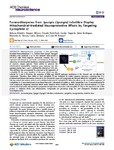Furanoditerpenes from Spongia (Spongia) tubulifera Display Mitochondrial-Mediated Neuroprotective Effects by Targeting Cyclophilin D

Use this link to cite
http://hdl.handle.net/2183/37543Collections
- Investigación (FCIE) [1228]
Metadata
Show full item recordTitle
Furanoditerpenes from Spongia (Spongia) tubulifera Display Mitochondrial-Mediated Neuroprotective Effects by Targeting Cyclophilin DAuthor(s)
Date
2022-07-28Citation
Alvariño, R.; Alfonso, A.; Pech-Puch, D.; Gegunde, S.; Rodríguez, J.; Vieytes, M. R.; Jiménez, C.; Botana, L. M. Furanoditerpenes from Spongia (Spongia) Tubulifera Display Mitochondrial-Mediated Neuroprotective Effects by Targeting Cyclophilin D. ACS Chem. Neurosci. 2022, 13 (16), 2449–2463. https://doi.org/10.1021/acschemneuro.2c00208.
Abstract
[Abstract] Neuroprotective properties of five previously described furanoditerpenes 1–5, isolated from Spongia (Spongia) tubulifera, were evaluated in an in vitro oxidative stress model in SH-SY5Y cells. Dose–response treatments revealed that 1–5 improved cell survival at nanomolar concentrations through the restoration of mitochondrial membrane potential and the reduction of reactive oxygen species. Their ability to prevent the mitochondrial permeability transition pore opening was also assessed, finding that 4 and 5 inhibited the channel at 0.001 μM. This inhibition was accompanied by a decrease in the expression of cyclophilin D, the main regulator of the pore, which was also reduced by 1 and 2. However, the activation of ERK and GSK3β, upstream modulators of the channel, was not affected by compounds. Therefore, their ability to bind cyclophilin D was evaluated by surface plasmon resonance, observing that 2–5 presented equilibrium dissociation constants in the micromolar range. All compounds also showed affinity for cyclophilin A, being 1 selective toward this isoform, while 2 and 5 exhibited selectivity for cyclophilin D. When the effects on the intracellular expression of cyclophilins A–C were determined, it was found that only 1 decreased cyclophilin A, while cyclophilins B and C were diminished by most compounds, displaying enhanced effects under oxidative stress conditions. Results indicate that furanoditerpenes 1–5 have mitochondrial-mediated neuroprotective properties through direct interaction with cyclophilin D. Due to the important role of this protein in oxidative stress and inflammation, compounds are promising drugs for new therapeutic strategies against neurodegeneration.
Keywords
Furanoditerpenes
Spongia (Spongia) tubulifera
Mitochondria
Cyclophilin
Neuroprotection
Oxidative stress
Spongia (Spongia) tubulifera
Mitochondria
Cyclophilin
Neuroprotection
Oxidative stress
Editor version
Rights
Atribución 4.0 Internacional
ISSN
1948-7193






